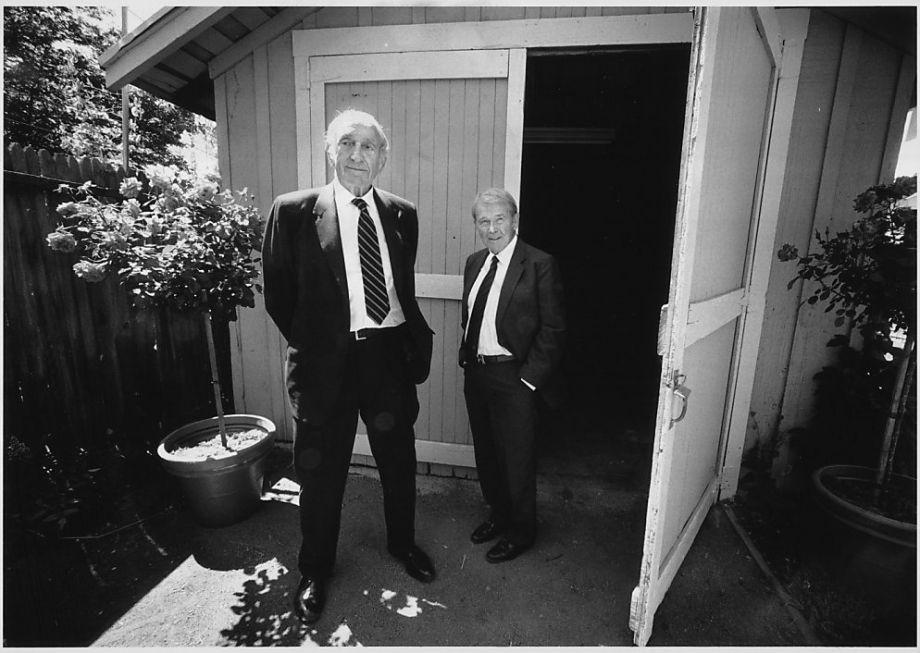
Fathers of Silicon Valley - Hewlett and Packard
If anyone deserves to be the pioneers of California's Silicon Valley, it certainly is these two gentlemen (1). It is from them and their work, Hewlett-Packard, that the general idea of technology startups starting in the garage comes. Because they actually started in a garage that, to this day, bought and restored by HP, stands as a tourist attraction in Palo Alto.
CV: William Redington Hewlett David Packard
Date of Birth: Hewlett - 20.05.1913/12.01.2001/07.09.1912 (Adjusted 26.03.1996/XNUMX/XNUMX) David Packard - XNUMX/XNUMX/XNUMX (Adjusted XNUMX/XNUMX/XNUMX)
Citizenship: American
Family status: Hewlett - married, five children; Packard - married, four children
Luck: both owned approximately $XNUMX billion HP at the time of their deaths
Education: Hewlett - Lowell High School in San Francisco, Stanford University; Packard - Centennial High School in Pueblo, Colorado, Stanford University
An experience: Founders of Hewlett-Packard and long-term members of the leadership (in various positions)
Additional achievements: recipients of the IEEE Founders Medal and many other technology awards and distinctions; Packard was also awarded the US Presidential Medal of Freedom and registered one of the first Internet domains, HP.com.
Interests: Hewlett - technique; Packard - innovative methods of company management, charity
HP Founders - Dave Packard and William "Bill" Hewlett - They met at Stanford University, where in the 30s, a group led by Professor Frederick Terman designed the first electronic devices.
They worked well together, so after studying at the university they decided to start manufacturing accurate sound generators in Hewlett's garage.
In January 1939 they jointly formed the company Hewlett-Packard. The HP200A audio generator was a profitable project.
The use of a light bulb as a resistor in key circuit elements meant that the product could be sold for much less than competitors' similar devices.
Suffice it to say that the HP200A cost $54,40, while third-party oscillators cost at least four times as much.
Both gentlemen quickly found a client for their product, as the Walt Disney Company used the equipment they designed in the production of the famous film "Fantasy".
Valley culture
Apparently, the order of the names in the company name was supposed to be determined by a coin toss. Packard won but eventually agreed to take over Hewlett. Recalling the start of the company, Packard said that at the time they didn't have a big idea that would lead them to get rich with the breakthrough.
Rather, they were thinking about supplying things that were not yet on the market, but were needed. During World War II, it was revealed that the US government was looking for generators and voltmeters that both men could produce. They got orders.
Cooperation with the army was so successful and fruitful that later, in 1969, Packard he temporarily left the company to serve as Deputy Secretary of Defense in the administration of President Richard Nixon.
From the very beginning of its existence, HP Dave Packard has specialized in tasks related to company management, while William Hewlett has focused on the technology side in research and development.
Already in the war years, Packard in his absence Hewlett, who had completed military service, experimented with the organization of work in the company. He abandoned the rigid work schedule and gave employees more freedom. The hierarchy in the company began to level out, the distance between management and employees was reduced.
A specific corporate culture of Silicon Valley was born, which Hewlett and Packard she was a founding mother, and her creators were considered fathers. For many years, HP has mainly produced electronic devices for electronics manufacturers and research and development centers.
First of all, it was high-class measuring equipment - oscilloscopes, voltmeters, spectrum analyzers, generators of various types. The company has many achievements in this field, introduced many innovative solutions and patented inventions.
The measuring equipment has been developed for high frequency (including microwave), semiconductor and integrated circuit technology. There were separate workshops for the production of microwave components, semiconductors, including integrated circuits and microprocessors, and optoelectronics.
Workshops were created for the production of electronic medical equipment (for example, heart monitors or electrocardiographs), as well as measuring and analytical equipment for the needs of science, for example. gas, liquid and mass spectrometers. The largest laboratories and research centers, including NASA, DARPA, MIT and CERN, became the company's customers.
In 1957, the company's shares were listed on the New York Stock Exchange. Shortly thereafter, HP partnered with Japan's Sony and Yokogawa Electric to develop and manufacture high-quality electronic products for the consumer market.
“In the period from 1955 to 1965. Hewlett-Packard was probably the greatest company in history,” says Michael S. Malone, author of books about the heroes of Silicon Valley (3). "They had the same level of innovation that Apple had for the last decade, and at the same time it was the most employee-friendly company in the United States with the highest morale in the ranks."
1. Older Dave Packard and Bill Hewlett
3. William Hewlett and David Packard in the 50s.
Computers or calculators
In the second half of the 60s, HP turned its attention to the computer market. In 1966, the HP 2116A (4) computer was created, which was used to control the operation of measuring instruments. Two years later, he appeared on the market. Hewlett-Packard 9100A, which many years later was named by Wired magazine as the first personal computer (6).
6. Hewlett-Packard 9100A calculator computer
However, the manufacturer himself did not define it as such, calling the machine a calculator. "If we called it a computer, our computer guru clients wouldn't like it because it didn't look like IBM," Hewlett later explained.
Equipped with a monitor, printer and magnetic memory, the 9100A was conceptually not too different from the PCs we are used to today. The first "real" personal computer Hewlett-Packard however, he did not produce it until 1980. He did not have success.
The machine was not compatible with the then dominant IBM PC standard. However, this did not stop the company from making further attempts in the computer market. An interesting fact is that in 1976 the company underestimated the prototype desktop computer it came with...
Steve Wozniak. Immediately after that, he founded Apple with Steve Jobs, who, at the age of twelve, William Hewlett himself estimated as an extremely talented child! “One wins, the other loses,” Hewlett later commented on Wozniak’s departure and his subordinates’ apparent lack of business acumen.
In the field of computers, HP allowed Apple to overtake. However, priority Hewlett-Packard in the category of pocket calculators, no one has any questions. In 1972, the first scientific pocket calculator HP-35 (2) was developed.
In the years that followed, the company steadily developed: the first pocket programmable calculator and the first programmable alphanumeric calculator. It was HP engineers, together with colleagues from Sony, who brought to the market a 3,5-inch floppy disk, which was innovative at that time and revolutionized the storage medium.
Printers Hewlett-Packard considered indestructible. The company then competed for the position of IT market leader with IBM, Compaq and Dell. Be that as it may, later HP won the market not only with its own inventions. For example, he acquired laser printing technology in the 70s from the Japanese company Canon, which did not appreciate his idea.
And that is why, thanks to the right business decision and the realization of the potential of a new solution, HP is now so famous in the computer printer market. As early as 1984, he introduced the HP ThinkJet, an inexpensive personal printer, and four years later, the HP DeskJet.
2. HP-35 calculator 1972.
4. 2116A - Hewlett-Packard's first computer
Split and merge
As a result of action taken against the company by the authorities on charges of monopolistic practices, the company was split in 1999 and an independent subsidiary, Agilent Technologies, was created to take over non-computer manufacturing.
Today Hewlett-Packard primarily a manufacturer of printers, scanners, digital cameras, handheld computers, servers, computer workstations, and computers for home and small businesses.
Many of the personal computers and notebooks in the HP portfolio come from Compaq, which merged with HP in 2002, making it the largest PC maker at the time.
Founding year of Agilent Technologies Hewlett-Packard was worth $8 billion and had 47 jobs. people. It was immediately (again) listed on the stock exchange and recognized as the biggest debut in Silicon Valley.
Dust?
That same year, Carly Fiorina, the first female CEO of the largest US public companies, assumed control of the Palo Alto corporate headquarters. Unfortunately, this happened during the economic crisis caused by the bursting of the Internet bubble.
5. Hewlett-Packard Research Center in France
It was also criticized for its merger with Compaq, when it was revealed that the merger of two powerful companies resulted in gigantic organizational problems instead of savings.
This continued until 2005, when the company's management asked her to resign.
Since then work Hewlett and Packard deal with changing happiness. After the crisis, new CEO Mark Hurd introduced draconian austerity, which improved the company's results.
The latter, however, held up well in traditional markets, recording further impressive failures in new areas - this ended, for example, an attempt to enter the tablet market.
In recent years, the company has changed its management twice, without achieving the expected results. Most of the talk lately is that HP wants to get out of the PC market, much like IBM, which first spun off its PC business and then sold it to Lenovo.
But many observers of Silicon Valley activity argue that the sources of HP's troubles must be traced back to a time much earlier than the aggressive actions of recent managers. Already earlier, in the 90s, the company developed mainly through business operations, acquisitions and cost reductions, and not - as in the past, during governments Packard with Hewlett – by creating innovative devices that people and companies need.
Hewlett and Packard died before all of the above stories began to happen in their company. The last one passed away in 1996, the first in 2001. Around the same time, the specific, employee-friendly culture with the traditional name, the HP Way, began to disappear in the company. The legend remains. And the wooden garage where two young electronics enthusiasts assembled their first generators.

